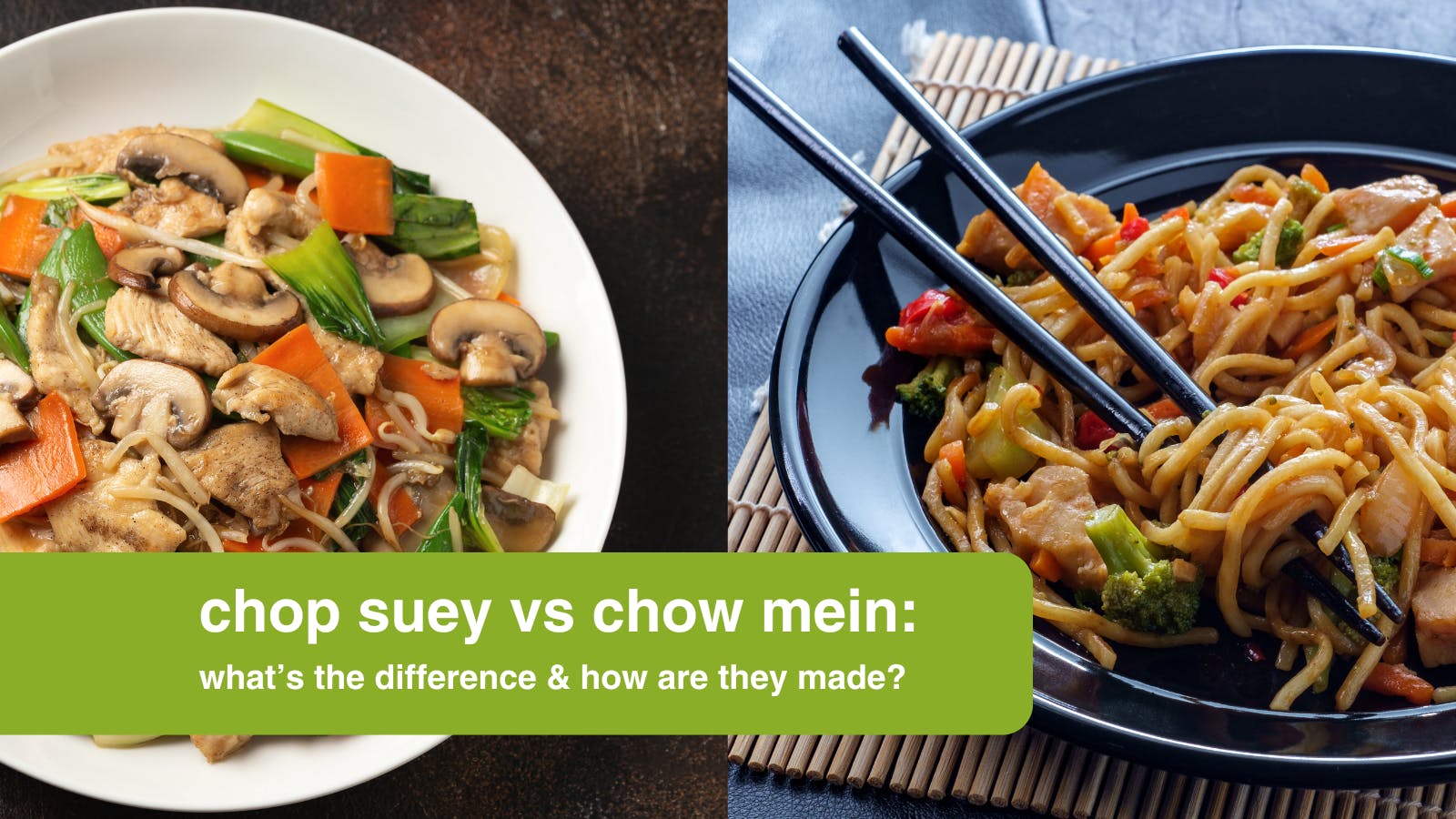your cart
Your cart is empty.
Chop Suey vs Chow Mein: What's the Difference and How are They Made?
Find out the differences between two iconic but frequently confused Chinese dishes - chop suey and chow mein!

Chinese cuisine is incredibly popular all around the world, and it’s not hard to see why! With a hugely diverse range of delicious dishes originating from regions all over the country, there are so many iconic recipes that have become firm favourites in the West.
Even if you’re not that familiar with Chinese food, you’ll have likely heard of both chop suey and chow mein. These tasty dishes are part of many people’s go-to Chinese takeaway order, but what exactly are they, and what are their origins?
We take a look at the difference between them here. If you’d like to have a go at making chop suey or chow mein yourself, check out our online Chinese supermarket to find all the ingredients you’ll need.
What is the Difference Between Chop Suey & Chow Mein?
- Origins: Chow mein is a traditonal Chinese dish, whereas as chop suey is a Chinese-American creation.
- Sauce: Chow mein tends to have a thin soy sauce-based sauce while chop suey often has a thicker gravy-like sauce.
- Serving: Chow mein is always served with noodles that have been boiled and then stir-fired with the other ingredients, whereas chop suey is usually served with rice (although noodles can be used too).
- Cooking method: For chow mein, the noodles are cooked and added to the other ingredients and fired together in the wok. For chop suey, the meat and veggies and rice/noodles are prepared separately, then served in the same bowl and topped with the sauce.
- Adaptability: Chow mein is quite a specific dish, while making chop suey is not as exact and can differ quite a lot depending on the chef.
A History of Chop Suey
While still having roots in Southern China, chop suey made its name as a Chinese-American dish. There are a couple of tales surrounding the invention of the dish.
One story claims that it originated in 1896 when it was served to the American guests of Chinese ambassador Li Hung Chang. Another story states it was first made when a Chinese chef in California who ran out of ingredients and had to cobble together a new dish with what he had on hand, creating chop suey.
The name ‘chop suey’ comes from the Cantonese phrase tsap sui, which translates to odds and ends and the Mandarin term tsa sui, which means miscellaneous broken pieces.
The origins of the name should give you a bit of a hint about what kind of ingredients you’ll find in chop suey and how it’s made!
What is Chop Suey?
There are countless variations of chop suey, with individual chefs creating their own unique recipes within the basic parameters of the dish.
Chop Suey will usually contain some kind of meat, whether this is beef, pork, chicken or seafood, an assortment of veggies, sometimes an egg and a thick sauce. This is then served with either noodles or rice, although rice is a more common and popular pairing.

A History of Chow Mein
Chow mein is often considered a more authentic, traditional Chinese dish and has firm origins in Northern China. Although the exact origin is not known, the dish has a firm place in Chinese culinary history.
Chow mein simply translates to ‘stir-fried noodles’.
Like chop suey, chow mein has made its way to the West and is enjoyed in many Chinese restaurants as an iconic dish.
What is Chow Mein?
So, how is chow mein different from chop suey?
Chow mein is also a dish that consists of meat, vegetables like cabbage or bok choy and a sauce, but unlike chop suey, it is always served with stir-fried noodles.
The noodles in chow mein are stir-fried with the other ingredients, giving them a succulent texture. The dish may also be confused with lo mein, but with this dish, the noodles are not fried and are cooked separately before being tossed together with the other ingredients.
The rules for chow mein are usually a little more strict than chop suey, which is generally a recipe that is up to interpretation and personal preference.

How are They Made?
Although the two dishes may seem similar, the way they are prepared sets them apart as distinct dishes.
The sauces for each dish are markedly different, with chop suey usually having a thicker, starchy gravy-like sauce, while chow mein is prepared with a thinner soy-sauce based topping.
How the dishes are prepared and served is also an area where they differ. With chow mein, you cook noodles and add them to your wok of other ingredients, cooking everything together in one pan.
However, with a chop suey recipe, you will cook the noodles or rice and other ingredients separately before combining them in a bowl, serving up the noodles or rice with the sauce served over the top.

Chop Suey Recipe
Have we tempted you to try a chop suey recipe yourself? Try our recipe below - you’ll be creating delicious at-home meals in no time.
You Will Need
- 150g rice
- 180g chicken, thinly sliced (or any other meat/alternative you prefer)
- Oil for cooking
- 1 garlic clove, minced
- ½ onion, finely chopped
- 1 carrot, peeled and chopped
- 6 stems of tender stem broccoli
- 60g mushrooms, sliced
- 1 pak choi, roughly chopped
- Handful of beans sprouts
For the sauce:
- 1tbsp cornflour
- 2tsp soy sauce
- 1tbsp Oyster sauce
- 1tbsp Chinese cooking wine
- 185ml water
Method:
1. Prepare the sauce by thoroughly combining the cornflour and soy sauce in a bowl. Add the other sauce ingredients.
2. Cook your rice according to the packet’s instructions while you prepare the stir-fry.
3. Heat the oil in a wok over a high heat before adding the garlic and onion. Cook for a minute or two.
4. Add the chicken and cook until it starts to turn white.
5. Add the broccoli, carrot and mushrooms - stir-fry for another minute.
6. Now add the pak choi and bean sprouts along with the sauce, stirring until the sauce thickens.
7. Serve with rice.

Chow Mein Recipe
Maybe you want to try chow mein? Give this recipe a go!
You Will Need:
- 200g chow mein noodles
- 180g chicken, thinly sliced (or any other meat/alternative you prefer)
- Oil for cooking
- 1 garlic clove, minced
- 300g green cabbage or Chinese leaf, shredded
- 3 green onions
- 1 carrot, peeled and chopped
- Handful of bean sprouts
- 65ml water
For the sauce:
- 1tbsp cornflour
- 2tsp soy sauce
- 1tbsp Oyster sauce
- 1tbsp Chinese cooking wine
- 2tsp sugar
- ½tsp sesame oil
Method:
1. Mix the sauce ingredients in a bowl until combined.
2. Prepare the noodles according to the packet’s instructions and set aside.
3. Heat the oil in a wok over a high heat before adding the garlic. Cook for a minute or two.
4. Add the chicken and cook until it starts to turn white.
5. Add the cabbage, spring onions and carrots - stir-fry until the cabbage is tender.
6. Add your noodles, sauce and 65ml of water, tossing everything together and stir-frying for a further minute.
7. Add the bean sprouts, cook for another minute.
8. Serve and enjoy!
Remember to stock up on our authentic Chinese ingredients to begin your exploration into the delicious world of Chinese cuisine! You can also check out our traditional Chinese bowls and tableware to perfect your dishes.
this site uses cookies
We and our advertising partners use cookies on this site and around the web to improve your website experience and provide you with personalised advertising from this site and other advertisers. By clicking allow, you accept the placement and use of these cookies for these purposes. Learn More



